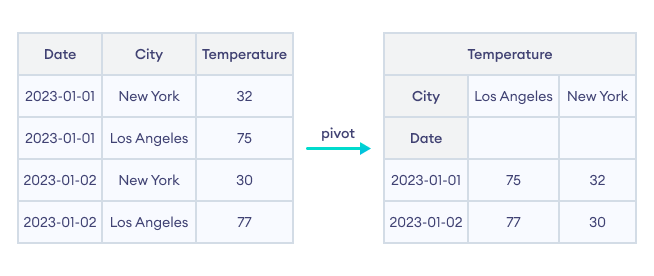Pandas 中的 pivot_table() 函数允许我们创建类似电子表格的数据透视表,从而更轻松地对数据进行分组和分析。

让我们看一个例子。
import pandas as pd
# create a dataframe
data = {'Date': ['2023-01-01', '2023-01-01', '2023-01-02', '2023-01-02'],
'City': ['New York', 'Los Angeles', 'New York', 'Los Angeles'],
'Temperature': [32, 75, 30, 77]}
df = pd.DataFrame(data)
print("Original DataFrame\n", df)
print()
# pivot the dataframe
pivot_df = df.pivot_table(index='Date', columns='City', values='Temperature')
print("Reshaped DataFrame\n", pivot_df)输出
Original DataFrame
Date City Temperature
0 2023-01-01 New York 32
1 2023-01-01 Los Angeles 75
2 2023-01-02 New York 30
3 2023-01-02 Los Angeles 77
Reshaped DataFrame
City Los Angeles New York
Date
2023-01-01 75 32
2023-01-02 77 30
在此示例中,我们将 DataFrame 重塑为以 Date 作为 index,以 City 作为 columns,以 Temperature 作为 values。
pivot_df DataFrame 是一个多维表,显示基于城市和日期的温度。
因此,pivot_table() 操作重塑了数据,使其更清晰以便进一步分析。
pivot_table() 语法
Pandas 中 pivot_table() 的语法是:
df.pivot_table(values=None, index=None, columns=None, aggfunc='mean', fill_value=None, dropna=True)这里,
index:用作行标签的列columns:将被重塑为列的列values:用于新 DataFrame 值的列aggfunc:用于聚合的函数,默认为'mean'fill_value:用于替换缺失值的变量dropna:是否排除所有条目均为 NaN 的列
示例:使用多个值进行 pivot_table()
如果我们在 pivot_table() 中省略 values 参数,它将选择所有剩余的列(除了指定的 index 和 columns)作为透视表的值。
import pandas as pd
# create a dataframe
data = {'Date': ['2023-01-01', '2023-01-01', '2023-01-02', '2023-01-02'],
'City': ['New York', 'Los Angeles', 'New York', 'Los Angeles'],
'Temperature': [32, 75, 30, 77],
'Humidity': [80, 10, 85, 5]}
df = pd.DataFrame(data)
print('Original DataFrame')
print(df)
print()
# pivot the dataframe
pivot_df = df.pivot_table(index='Date', columns='City')
print('Reshaped DataFrame')
print(pivot_df)输出
Original DataFrame
Date City Temperature Humidity
0 2023-01-01 New York 32 80
1 2023-01-01 Los Angeles 75 10
2 2023-01-02 New York 30 85
3 2023-01-02 Los Angeles 77 5
Reshaped DataFrame
Humidity Temperature
City Los Angeles New York Los Angeles New York
Date
2023-01-01 10 80 75 32
2023-01-02 5 85 77 30
在此示例中,我们为多个值(即 Temperature 和 Humidity)创建了一个数据透视表。
使用聚合函数进行 pivot_table()
我们可以使用 aggfunc 参数将 pivot_table() 方法与不同的聚合函数一起使用。我们可以将 aggfunc 的值设置为诸如 'sum'、'mean'、'count'、'max' 或 'min' 之类的函数。
让我们看一个例子。
import pandas as pd
data = {'Date': ['2023-01-01', '2023-01-01', '2023-01-02', '2023-01-02', '2023-01-03', '2023-01-03'],
'City': ['New York', 'Los Angeles', 'New York', 'Los Angeles', 'New York', 'Los Angeles'],
'Temperature': [32, 75, 30, 77, 33, 78],
'Humidity': [80, 10, 85, 5, 81, 7]}
df = pd.DataFrame(data)
# calculate mean temperature for each city using pivot_table()
mean_temperature = df.pivot_table(index='City', values='Temperature', aggfunc='mean')
print(mean_temperature)输出
Temperature City Los Angeles 76.666667 New York 31.666667
在上面的示例中,我们使用 pivot_table() 中的 aggfunc='mean' 参数计算了每个城市的平均温度。
带有 MultiIndex 的数据透视表
我们可以使用 pivot_table() 函数创建带有 MultiIndex 的数据透视表。
让我们看一个例子。
import pandas as pd
# create a dataframe
data = {'Date': ['2023-01-01', '2023-01-01', '2023-01-02', '2023-01-02', '2023-01-01', '2023-01-01', '2023-01-02', '2023-01-02'],
'City': ['New York', 'Los Angeles', 'New York', 'Los Angeles','Delhi', 'Chennai', 'Delhi', 'Chennai'],
'Country': ['USA', 'USA', 'USA', 'USA', 'India', 'India', 'India', 'India'],
'Temperature': [32, 75, 30, 77, 75, 80, 78, 79]}
df = pd.DataFrame(data)
print("Original DataFrame\n", df)
print()
# create a pivot table with multiindex
pivot_df = df.pivot_table(index=['Country', 'City'], columns='Date', values='Temperature')
print("Reshaped DataFrame\n", pivot_df)输出
Original DataFrame
Date City Country Temperature
0 2023-01-01 New York USA 32
1 2023-01-01 Los Angeles USA 75
2 2023-01-02 New York USA 30
3 2023-01-02 Los Angeles USA 77
4 2023-01-01 Delhi India 75
5 2023-01-01 Chennai India 80
6 2023-01-02 Delhi India 78
7 2023-01-02 Chennai India 79
Reshaped DataFrame
Date 2023-01-01 2023-01-02
Country City
India Chennai 80 79
Delhi 75 78
USA Los Angeles 75 77
New York 32 30
在此示例中,我们通过将列列表作为 index 参数传递,创建了一个带有 MultiIndex 的数据透视表。
MultiIndex 包含多个索引级别,列之间通过父/子关系相互关联。在这里,Country 是父列,City 是子列。
使用 pivot_table() 处理缺失值
有时在使用 pivot_table() 重塑数据时,数据透视表中可能会出现缺失值。此类缺失值或 NaN 值可以通过 fill_value 和 dropna 参数在 pivot_table() 操作中进行处理。
dropna 参数指定是否删除所有条目均为 NaN 的列。dropna 的默认值为 True。
让我们看一个例子。
import pandas as pd
import numpy as np
# Creating the DataFrame
data = {'Date': ['2023-01-01', '2023-01-01', '2023-01-02', '2023-01-02', '2023-01-03', '2023-01-03', '2023-01-03'],
'City': ['New York', 'Los Angeles', 'New York', 'Los Angeles', 'New York', 'Los Angeles', 'Chicago'],
'Temperature': [32, 75, 30, 77, np.nan, 76, np.nan]}
df = pd.DataFrame(data)
# create a pivot table
pivot_df = df.pivot_table(index='Date', columns='City', values='Temperature')
print("\nDefault Pivot Table\n", pivot_df)
# create a pivot table with dropna=True
pivot_df_dropna = df.pivot_table(index='Date', columns='City', values='Temperature', dropna=False)
print("\nPivot Table with dropna=False:\n", pivot_df_dropna)输出
Default Pivot Table City Los Angeles New York Date 2023-01-01 75.0 32.0 2023-01-02 77.0 30.0 2023-01-03 76.0 NaN Pivot Table with dropna=False: City Chicago Los Angeles New York Date 2023-01-01 NaN 75.0 32.0 2023-01-02 NaN 77.0 30.0 2023-01-03 NaN 76.0 NaN
在此示例中,我们使用 dropna 函数来确定如何处理完全为 NaN 条目的列。默认情况下,dropna 参数设置为 True,导致 Chicago 列被自动删除。
请注意,New York 列未被删除,尽管它有一个 NaN 值。这是因为 dropna 会删除所有条目均为 NaN 的列。
另一方面,fill_value 参数将所有 NaN 值替换为指定的值。例如,
import pandas as pd
import numpy as np
# Creating the DataFrame
data = {'Date': ['2023-01-01', '2023-01-01', '2023-01-02', '2023-01-02', '2023-01-03', '2023-01-03'],
'City': ['New York', 'Los Angeles', 'New York', 'Los Angeles', 'New York', 'Los Angeles'],
'Temperature': [32, np.nan, 30, 77, np.nan, 76]}
df = pd.DataFrame(data)
# create a pivot table
pivot_df = df.pivot_table(index='Date', columns='City', values='Temperature')
print("\nDefault Pivot Table\n", pivot_df)
# create a pivot table with fill_value=0
pivot_df_dropna = df.pivot_table(index='Date', columns='City', values='Temperature', fill_value=0)
print("\nPivot Table with fill_value=0:\n", pivot_df_dropna)输出
Default Pivot Table City Los Angeles New York Date 2023-01-01 NaN 32.0 2023-01-02 77.0 30.0 2023-01-03 76.0 NaN Pivot Table with fill_value=0: City Los Angeles New York Date 2023-01-01 0 32 2023-01-02 77 30 2023-01-03 76 0
在此示例中,我们使用 fill_value=0 参数将 NaN 值替换为 0。
pivot() 与 pivot_table() 的区别
pivot() 和 pivot_table() 函数执行类似的操作,但有一些关键区别。
| 依据 | pivot() | pivot_table() |
|---|---|---|
| 聚合 | 不允许数据聚合。 | 允许聚合(求和、平均值、计数等)。 |
| 重复索引 | 无法处理重复的索引值。 | 可以处理重复的索引值。 |
| MultiIndex | 仅接受单级索引。 | 接受多级索引以处理复杂数据。 |
